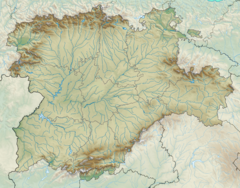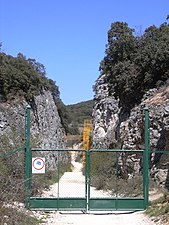
The Province of Burgos is a province of northern Spain, in the northeastern part of the autonomous community of Castile and León. It is bordered by the provinces of Palencia, Cantabria, Vizcaya, Álava, La Rioja, Soria, Segovia, and Valladolid. Burgos is the province of Spain that has borders with most provinces. Its capital is the city of Burgos.
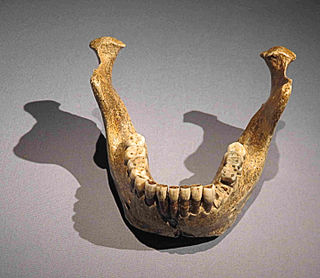
Homo heidelbergensis is an extinct species or subspecies of archaic human which existed during the Middle Pleistocene. It was subsumed as a subspecies of H. erectus in 1950 as H. e. heidelbergensis, but towards the end of the century, it was more widely classified as its own species. It is debated whether or not to constrain H. heidelbergensis to only Europe or to also include African and Asian specimens, and this is further confounded by the type specimen being a jawbone, because jawbones feature few diagnostic traits and are generally missing among Middle Pleistocene specimens. Thus, it is debated if some of these specimens could be split off into their own species or a subspecies of H. erectus. Because the classification is so disputed, the Middle Pleistocene is often called the "muddle in the middle".

Homo antecessor is an extinct species of archaic human recorded in the Spanish Sierra de Atapuerca, a productive archaeological site, from 1.2 to 0.8 million years ago during the Early Pleistocene. Populations of this species may have been present elsewhere in Western Europe, and were among the first to colonise that region of the world, hence the name. The first fossils were found in the Gran Dolina cave in 1994, and the species was formally described in 1997 as the last common ancestor of modern humans and Neanderthals, supplanting the more conventional H. heidelbergensis in this position. H. antecessor has since been reinterpreted as an offshoot from the modern human line, although probably one branching off just before the modern human/Neanderthal split.

Prehistoric Europe refers to Europe before the start of written records, beginning in the Lower Paleolithic. As history progresses, considerable regional unevenness in cultural development emerges and grows. The region of the eastern Mediterranean is, due to its geographic proximity, greatly influenced and inspired by the classical Middle Eastern civilizations, and adopts and develops the earliest systems of communal organization and writing. The Histories of Herodotus is the oldest known European text that seeks to systematically record traditions, public affairs and notable events.

Ceprano Man, Argil, and Ceprano Calvarium, is a Middle Pleistocene archaic human fossil, a single skull cap (calvarium), accidentally unearthed in a highway construction project in 1994 near Ceprano in the Province of Frosinone, Italy. It was initially considered Homo cepranensis, Homo erectus, or possibly Homo antecessor; but in recent studies, most regard it either as a form of Homo heidelbergensis sharing affinities with African forms, or an early morph of Neanderthal.
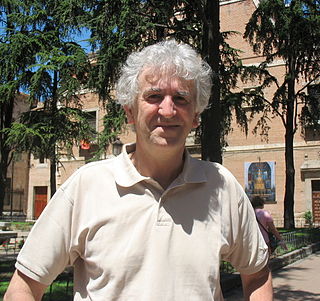
Juan Luis Arsuaga Ferreras is a Spanish paleoanthropologist and author known for his work in the Atapuerca Archaeological Site.
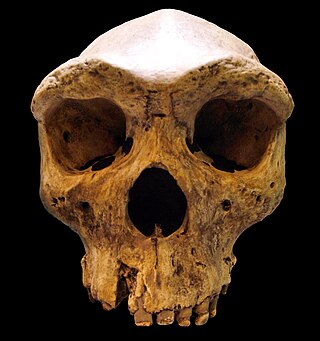
Archaic humans is a broad category denoting all species of the genus Homo that are not Homo sapiens. Among the earliest modern human remains are those from Jebel Irhoud in Morocco, Florisbad in South Africa (259 ka), and Omo-Kibish I in southern Ethiopia. Some examples of archaic humans include H. antecessor (1200–770 ka), H. bodoensis (1200–300 ka), H. heidelbergensis (600–200 ka), Neanderthals, H. rhodesiensis (300–125 ka) and Denisovans,
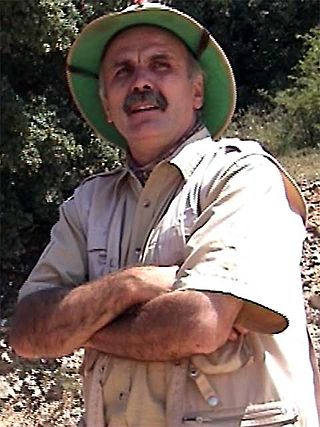
Eudald Carbonell i Roura is a Spanish archaeologist, anthropologist and paleontologist.
Paleolithic Europe, or Old Stone Age Europe, encompasses the Paleolithic or Old Stone Age in Europe from the arrival of the first archaic humans, about 1.4 million years ago until the beginning of the Mesolithic around 10,000 years ago. This period thus covers over 99% of the total human presence on the European continent. The early arrival and disappearance of Homo erectus and Homo heidelbergensis, the appearance, complete evolution and eventual demise of Homo neanderthalensis and the immigration and successful settlement of Homo sapiens all have taken place during the European Paleolithic.

Miguelón is the popular nickname for a human skull, classified as either late Homo heidelbergensis or as early Homo neanderthalensis. It has been estimated to date to 430,000 years ago. It is one of more than 5,500 fossils belonging to early human populations which have been found in the Sima de los Huesos site in the Sierra de Atapuerca in northern Spain.
Dolinasorex glyphodon was a species of giant venomous shrew that is now extinct. Remains of the animal were found at the Gran Dolina site, located in the Sierra de Atapuerca, Burgos, Spain by researchers from the University of Zaragoza, Spain between 1991 and 2007. The deposit is estimated to be between 780,000 and 900,000 years old. D. glyphodon was the only species in the genus Dolinasorex.
Hominid dispersals in Europe refers to the colonisation of the European continent by various species of hominid, including hominins and archaic and modern humans.

The Museum of Human Evolution is situated on the south bank of the river Arlanzón, in the Spanish city of Burgos. It is located roughly 16 kilometers west of the Sierra de Atapuerca, the location of some of the most important human fossil finds in the world. In addition, the Archaeological site of Atapuerca, which was declared a World Heritage Site in 2000, has yielded some of the exhibits at the museum.

Tautavel Man refers to the archaic humans which—from approximately 550,000 to 400,000 years ago—inhabited the Caune de l’Arago, a limestone cave in Tautavel, France. They are generally grouped as part of a long and highly variable lineage of transitional morphs which inhabited the Middle Pleistocene of Europe, and would eventually evolve into the Neanderthals. They have been variably assigned to either H. (s.?) heidelbergensis, or as a European subspecies of H. erectus as H. e. tautavelensis. The skull is reconstructed based on the specimens Arago 21 and 47, and it is, to a degree, more characteristic of what might be considered a typical H. erectus morphology than a typical H. heidelbergensis morphology. The brain capacity is 1,166 cc. They seem to have had an overall robust skeleton. Average height may have been 166 cm.
Boxgrove Man is a name given to three fossils of early humans, found at Boxgrove in Sussex, and dated to about 480,000 years old. One piece of the tibia (shinbone) and two teeth were found. The tibia was of a mature well-built man, perhaps from the common ancestor of modern humans and Neanderthals, and the teeth are thought to be of early Neanderthals. They are the oldest fossils of the genus homo found in Britain.
Ursus dolinensis is an extinct mammalian carnivore species of the Ursidae family. Its fossilized remains were unearthed from the lowest layers of the stratigraphic sequence at the archaeological and paleontological site of Gran Dolina, that is a part of the Atapuerca Mountains complex in the Burgos province, northern Spain. The species was described by Nuria Garcia and Juan Luis Arsuaga in a 2001 publication. Skeletal fossils, mainly cranial fragments were recovered from the sediment units TD 3 and in particular TD 4. Presence in these layers suggests a chronology in between 900,000 and 780,000 years ago, which falls into the Calabrian stage of the early Pleistocene.

The archaeological site of Atapuerca is located in the province of Burgos in the north of Spain and is notable for its evidence of early human occupation. Bone fragments from around 800,000 years ago, found in its Gran Dolina cavern, provide the oldest known evidence of hominid settlement in Western Europe and of hominid cannibalism anywhere in the world.

Balanica is a cave complex and paleoarchaeological site in the City of Niš' municipality of Niška Banja in southeast Serbia. It consists of Velika Balanica and Mala Balanica. The entrances of two caves are 7 m (23 ft) apart, at an elevation of 329 m (1,079 ft), and form one cave system. A third cave, Pešturina, is also nearby. The two Balanica caves extend parallel to each other, likely being connected at the rear.

Paleolithic in the Iberian peninsula is the longest period of its prehistory, starting c. 1.3 million of years (Ma) ago and ending almost at the same time as Pleistocene, first epoch of Quaternary, c. 11.500 years or 11.5 ka ago. It was a period characterized by climate oscillations between ice ages and small interglacials, producing heavy changes in Iberia's orography. Cultural change within the period is usually described in terms of lithic industry evolution, as described by Grahame Clark.


